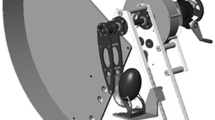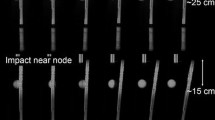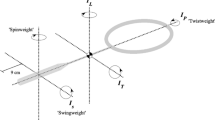Abstract
The kinematics of the racket and ball near impact in tennis forehands were studied to document typical variation in successful and unsuccessful shots, in order to determine biomechanically meaningful differences in advanced players and confirm models of groundstroke trajectories. Seven tennis players (six males and one female) were videoed from the side at 180 Hz as they performed 40 forehand drives on an indoor tennis court. Vertical plane kinematics of the racket and ball near impact were analysed for sub samples of successful and unsuccessful shots for each subject. Most racket kinematic variables were very consistent (mean CV< 6.3%) for successful shots, so bio mechanically meaningful differences in angles and velocities of the racket and ball (3° and 2 m s−1) near impact could be detected between successful and unsuccessful shots. Four subjects tended to miss long and three subjects missed shots in the net that were reflected in initial ball trajectories. Mean (SD) initial trajectories for long shots were 9.8° (1.4°), while netted shots were 0.7° (1.1°) above the horizontal. The initial ball trajectories and margins for error for these subjects were smaller than those previously reported (Brody, 1987) because players tended to select mean ball trajectories close to one error than another, differing amounts of topspin, or incorrect lift and drag coefficients for tennis balls had not been published when this model was created. The present data can be used to confirm if recent models (Cookeet al., 2003; Dignallet al., 2004) more closely match actual performance by advanced players.
Similar content being viewed by others
References
Bates, B.T, Dufek, J.S. & Davis, H.P. (1992) The effect of trial size on statistical power.Medicine and Science in Sports & Exercise,24, 1059–1068.
Brody, H. (1987)Tennis Science for Tennis Players. University of Pennsylvania Press, Philadelphia.
Cooke, A.J., Pallis, J.M. & Bankhurst, A. (2003) Sports engineering in education: an interactive computer-based tool for educating coaches on the science of tennis. In:Proceedings, 2nd International Congress on Tennis Science and Technology. (ed. Miller, S.), pp. 287–292. Webcom: Toronto.
Dignall, R.J., Goodwill, S.R., Haake, S.J. & Miller, S. (2004) Tennis GUT-modeling the game. In:The Engineering of Sport 5: Volume 2 (eds. Hubbard, M., Metha, R.D. & J.M. Pallis), pp. 382–388. ISEA, Sheffield.
Dufek, J.S., Bates, B., Sterogiu, N. & James, C.R. (1995) Interactive effects between group and single-subject response patterns.Human Movement Science,14, 301–323.
Elliott, B., Marsh, T & Overheu, P. (1989) A biomechanical comparison of the multisegment and single unit topspin forehand drives in tennis.International Journal of Sport Biomechanics,5, 350–364.
Goodwill, S.R., Chin, S.B. & Haake, S.J. (2004) Aerodynamics of spinning and non-spinning tennis balls.Journal of Wind Engineering & Industrial Aerodynamics,92, 935–958.
Knudson, D. (1993) Effect of string tension and impact location on ball rebound accuracy in static tennis impacts.Journal of Applied Biomechanics,9, 143–148.
Knudson, D. (1990) Intrasubject variability of upper extremity angular kinematics in the tennis forehand drive.International Journal of Sport Biomechanics,6, 415–421.
Knudson, D. & Bahamonde, R. (2001) Effect of endpoint conditions on position and velocity at impact in tennis.Journal of Sports Sciences,19, 839–844.
Knudson, D. & Bahamonde, R. (1999) Trank and racket kinematics at impact in the open and square stance tennis forehand.Biology of Sport,16, 3–10.
Knudson, D. & Elliott, B. (2004) Biomechanics of tennis strokes. In:Biomedical Engineering Principles in Sports. (eds. Hung, G.K. & Pallis, J.M.), pp. 153–181. Kluwer Academic/Plenum Publishers, New York.
Mehta, R.D. & Pallis, J.M. (2001) The aerodynamics of a tennis ball.Sports Engineering,4, 177–189.
Mullineaux, D.R., Bartlett, R.M. & Bennett, S. (2001) Research design and statistics in biomechanics and motor control.Journal of Sports Sciences,19, 739–760.
Salo, A. & Grimshaw, P.N. (1998) An examination of kinematic variability of motion analysis in sprint hurdles.Journal of Applied Biomechanics,14, 211–222.
Takahashi, K., Elliott, B. & Noffal, G. (1996) The role of upper limb segment rotations in the development of spin in the tennis forehand.Australian Journal of Science and Medicine in Sport,28, 106–113.
Author information
Authors and Affiliations
Corresponding author
Rights and permissions
About this article
Cite this article
Knudson, D.V., Blackwell, J.R. Variability of impact kinematics and margin for error in the tennis forehand of advanced players. Sports Eng 8, 75–80 (2005). https://doi.org/10.1007/BF02844005
Issue Date:
DOI: https://doi.org/10.1007/BF02844005




